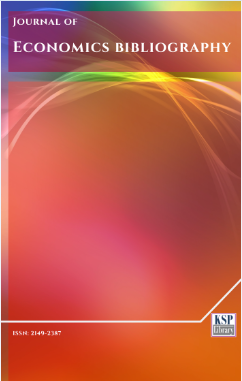Sectoral Impact of World Bank Loans to India in the Pre and Early Liberalisation Period: An Assessment of Agriculture, Social and Power Sectors
Abstract
Abstract. India’s relations with the World Bank can be traced back to the latter’s origin. India was one of the 17 countries, prepared the agenda for the Bretton Woods Conference ( June 1944). It was also one of the 44 countries which signed the final agreement for the establishment of the Bank. As the Bank operates in India through many kinds of projects, the country obviously offers an experimental ground for learning lessons and getting insights. In the mid of 20th century India assisted the World Bank, by facilitating it to study various problems in sectors like agricultural, social and power sectors to learn and, to “increase its understanding of the fundamental interactions of agriculture, poverty alleviation, and environment development efforts”. Based on these studies World Bank started to suggest policy prescriptions to various problems in these sectors and subsequently what was emerged as and conditionalities based funding. The article provides an insight understanding of the impact of these loans in general and in Agriculture, Social and Power sectors in particular. It confines till the middle of 1990’s from when the actual liberalization period started before engaging the country to a rapid economic growth.
Keywords. World Bank and India, Economic policy, Adjustment, Macro economy, Agricultural sector, Social sector, Power sector.
JEL. A10, E20, H50, N40, O12.
References
Acharaya, S.S., & Choudhary, D.P. (2001). Indian Agricultural Policy at the Cross Roads. Jaipur: Rawat Publication.
Acharya, S.S., & Choudhary, D.P. (2001). Equity Driven Trade and Marketing Policy Strategies for Indian Agriculture: Priority and Agenda, Jaipur: Rawat Publication.
Bajaj, J.C. (1998). Economic Reforms The Road Ahead. New Delhi: Delhi Policy Group.
Bates, R.H., & Kruegar, A.O. (1993). Political and Economic Policy Reform. Cambridge: Cambridge University Press.
Catherine, C., (1996). Masters of Illusion. London: Macmillian.
Chand, R. (1997). Removal of import restriction and Indian agriculture: The challenge and strategy. Economic and Political Weekly, 33(15), 850-854
Gilbert, C.L., & Vines, D. (2000). The World Bank Structure and Policies. Cambridge: Cambridge University Press.
Gulati, A., & Sharma A. (1997). Freeing trade in agriculture; Implication for resource use efficiency and cropping pattern changes. Economic and Political Weekly, 32(52), 150-154.
Gulati, A., & Sharma, A.N. (1994). Agriculture under GATT: What it hold for India. Economic and Political Weekly, 29. 1857.
Gulati, A., & Sharma, A. (1995). Subsidy syndrome in Indian agriculture. Economic and Political Weekly, 30, 1112.
Hans, A. (1986). Power Sector in India. New Delhi: Sterling Publishing House.
Hoggard, S., & Kauffman, R. (1992). The Policies of Economic Adjustment. Princeton: Princeton University Press.
Kauler, M. (1990). Orthodoxy and its Alternative: Explaining Approaches to Stabilization and Adjustment. Princeton: Princeton University Press.
Khanna, K. (1997). Current Economic Issues and Trends. Jaipur: Printwell.
Khate, D. (1999). India Country Assistance Evaluation: Evaluating Bank Assistance to India for Private Sector Development, 1989-1999. Washington. D.C.: World Bank.
Kumar, N. (2000). Indian Economy under Reforms. In, Panchamukhi, (ed.), Social Impact of Economic Reforms: A Critical Analysis. New Delhi: RIS.
Lele, U., & Bumb, B. (1994). South Asia: Food Crises. World Development Report (World Bank, 1994).
Lipton, M.,&Toye, J. (1990). Does Aid Work in India? A Country Study of Official Development Assistance. London: Routledge.
Pellekaan, J.H. (1999). India: Country Assistance Evaluation: Evaluating Bank Assistance to India for Agriculture and Rural Development. Washington D.C: World Bank.
Rangarajan, C. (2000). Perspectives on Indian Economy. New Delhi: UBSBD.
Rao, C.H.H., & Gulati A. (1994). Indian Agriculture: Emerging Perspective and Policy Issues. Economic and Political Weekly, 29. 158.
Rao, C.H.H. (1992). Integrating Poverty Alleviation Programmes with Development Strategies: Indian Experience. Economic and Political Weekly, 27, 2903.
Rao, C.H.H. (1994). Reforming Agriculture in the New Context. Economic and Political Weekly, 29, 1005.
Shrumer-Smith, P. (2000). India: Globalisation and Change. London: Arnold Publishers.
Swaminathan, M. (1996). Structural Adjustment, Food Security and System of Public Distribution ofFood. Economic and Political Weekly, 31, 1665.
The World Bank (1995). India: Live Sector Review: Enhancing Growth and Development. New Delhi: Allied Publishers.
World Bank (1999). The Irrigation Sector in India. New Delhi: Allied Publishers, p.3.
World Bank, India: 1991 Country Economic Memorandum, 2, 1.
DOI: http://dx.doi.org/10.1453/jeb.v2i3.447
Refbacks
- There are currently no refbacks.
.......................................................................................................................................................................................................................................................................................................................................
Journal of Economics Bibliography - J. Econ. Bib. - JEB - www.kspjournals.org
ISSN: 2149-2387.
Editor: [email protected] Secretarial: [email protected] Istanbul - Turkey.
Copyright © KSP Library

